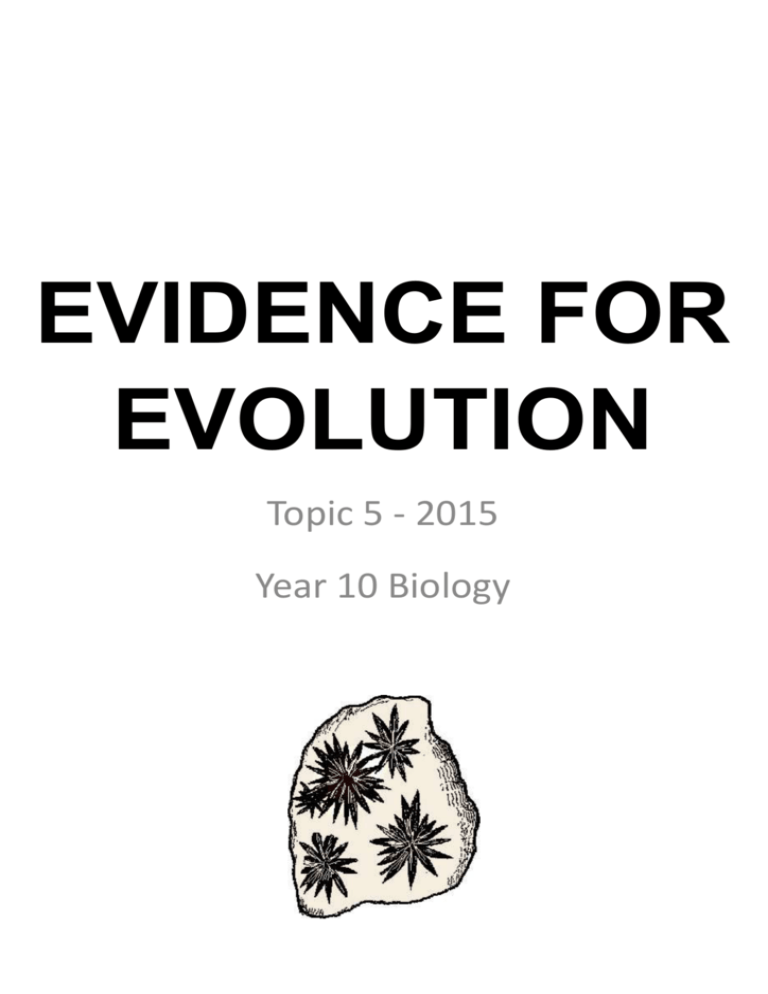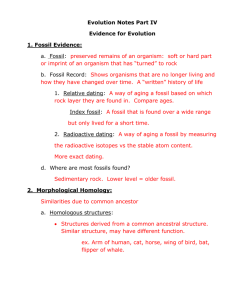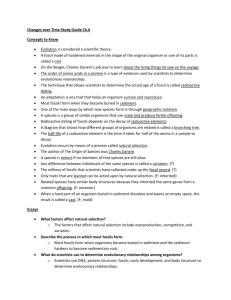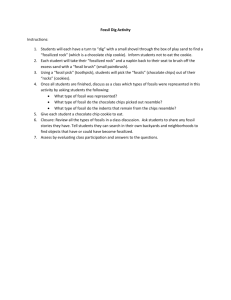Student notes – Evidence for Evolution
advertisement

EVIDENCE FOR EVOLUTION Topic 5 - 2015 Year 10 Biology TOPIC 5 – EVIDENCE FOR EVOLUTION Things to cover: 1. Biogeography 2. Fossil record 3. Comparing molecules 4. Comparing anatomy Work to do: 1. Worksheet – Long, long ago 2. Worksheet – Fossils 3. Worksheet – Patterns, order & organisation Ideas to know: Biogeography Fossil record Types of fossil Fossil formation Archeopteryx lithographica DNA hybridisation Comparing proteins Comparing anatomy Homologous structures Analogous structures REVIEW TOPIC 4 Are these statements about natural selection true or false? • Natural selection is another name for evolution. __________ • Natural selection is a theory proposed by Charles Darwin. __________ • Only the biggest individuals of a species survive and pass on their characteristics. • __________ Natural selection favours individuals that are best adapted to their environment. __________ • Evolution occurs as a result of natural selection. __________ • Variation within a species is very important if natural selection and evolution are to take place. __________ Complete these sentences about evolution: 1. Fossils show that all species have _____________ from simple life forms over the space of 3 _____________ years. 2. Each population that arose showed _____________ due to gene mutations. 3. Natural _____________ allowed individuals with _____________ most suited to their environment to survive and breed. 4. Useful genes were passed to the next generations so new ______________ gradually evolved. 5. Many species became extinct due to _____________ in the environment or the appearance of new competitors, _____________, or diseases. BIOGEOGRAPHY • Refers to ____________________ ____________________ of ____________________ • Evolution would suggest that ____________________ would exist between ____________________ and those ____________________ in that ____________________ in the ____________________. • If organisms arose by ‘special creation’, we would expect that similar habitats in different parts of the world would contain similar plant and animals. • But they don’t…. • We find that ____________________ ____________________ live in similar habitats in different parts of the world. • In Australia, our deserts contain spinnifex ____________________ and ________________________________. American deserts contain ____________________. The FOSSIL RECORD • Refers to the record kept of the ____________________ of ____________________ in the ____________________ • Fossils don’t have to be ____________________! • They can also be: − ____________________ − ____________________ − ____________________ − ____________________ − ____________________ − ____________________ , etc • Steps: 1. Organism ____________________ 2. ____________________ by dirt, mud, silt or lava before ____________________ can occur 3. The material that lies above the fossil ____________________, forming ____________________ 4. This ____________________ the fossil. Even if the organism itself ____________________ at a later stage, the __________________ will remain in the rock. • Fossilisation is rare! − It has to be __________________ __________________ it ____________________. − It has to be buried in an area that ____________________ ____________________. ie. no silt, no fossil − Whole organism may not be fossilised due to an attack by ____________________ before being buried. − Different types of fossil form under ____________________ ____________________ and environments. − Fossilized remains only form in the ____________________ of ____________________, which need food, oxygen, water and warmth. The FOSSIL RECORD • Finding a fossil is also rare! − You need to know ____________________ to ____________________! And even then, its hard! − May only find ____________________; not enough to get the whole picture of that organism. − May only find ____________________ ____________________. Good scientists never rely on one piece of evidence to draw a good ____________________. − May only find ____________________ ____________________. Many species are ____________________ ____________________ – meaning that males and females differ. • If a new species evolves from an ____________________ ____________________, the fossil record should contain organisms that are ____________________ with some ____________________ of ____________________ the modern and ancestral forms. • • One fossil type found is ____________________ ____________________. REPTILE FEATURES BIRD FEATURES COMPARING MOLECULES • Scientists can ____________________ a variety of molecules in order to determine whether two species are ____________________ or ____________________ related. • eg: − ____________________ − ___________________________________ ____________________ & ____________________ • DNA HYBRIDISATION − All organisms contain DNA in their cells. − Double stranded DNA can be ____________________ so that it ____________________ into ____________________ ____________________. − A single strand from one organism can be placed next to a single strand from another organism and ____________________ ____________________. − The two single strands will bond to each other (hybridise) where complementary bases are found. − If the strands are similar, a high amount of pairing will take place. • − eg. + _________________________________________ − eg. + __________________________________________ COMPARING PROTEINS − All organisms share a number of proteins. − ____________________ is an ____________________ needed for ____________________. − If we compare the ____________________ ____________________ ____________________ of Cytochrome C in different organisms, we find that closely related organisms have very similar Cytochrome C. COMPARING MOLECULES Organism No. of changes in amino acid sub units relative to humans Human Rhesus monkey Whale Chicken Tuna fish – The _________________ that two species _________________ from a _________________ _________________, the more time there has been for _________________ to occur in the amino acid sequence. – This shows that _________________ and _________________ are more closely related than _________________ and _________________. COMPARING ANATOMY • Scientists look for similarities in ____________________ ____________________ and ____________________ in order to investigate common ancestry. • These similarities are called ____________________. • Species that share ____________________ ____________________ share similarities because they have a ____________________ ____________________. • eg: − The ____________________ of all ____________________ is very similar in the number and structure of the bones present. • ____________________ ____________________ also exist. • These are ____________________ in ____________________ that have evolved due to ____________________ ____________________ ____________________ ____________________. • eg: − SQ10 - CHAPTER 3 Question Response 1. What name was given to the landmass to which Australia belonged 250 million years ago? 2. a) How many supercontinents were formed? b) How many years ago? c) What were their names? 3. List the 5 pieces of evidence to support the theory that supercontinents once existed: i. ii. iii. iv. v. 4. What is a fossil? 5. What could be considered to be a fossil? 6. Briefly describe the 4 steps involved in the formation of a fossil. (4marks) 1. 2. 3. 4. 7. What is the name given to a scientist who studies fossils? 8. What is absolute dating? 9. What chemical is used for absolute dating? 10. What is relative dating? 11. What is the Scientific name for the bird skeleton found in Bavaria? 12. Name the features of this skeleton that were similar to modern birds. 13. Name the features of this skeleton that were similar to reptiles. 14. What conclusion did scientists draw from the discovery of this fossil? 15. Why are so few organisms preserved as fossils? (2marks) 16. Why is the fossil record incomplete? (2marks) Question Response 17. List the 4 principles that form the 1. basis for Darwin’s theory of 2. natural selection. 3. 4. 18. What term is given to the formation of a new species? 19. List the 4 different types of evidence used to support Darwin’s theory of evolution. 20. What is convergent evolution? 21. Compare analogous and homologous structures. (2 marks) Analogous Homologous 22. a) Describe the process of DNA hybridisation? b) How is it used to identify related organisms? 23. Compare artificial and natural selection. (2 marks) Artificial selection Natural selection






